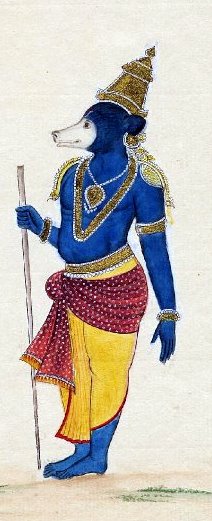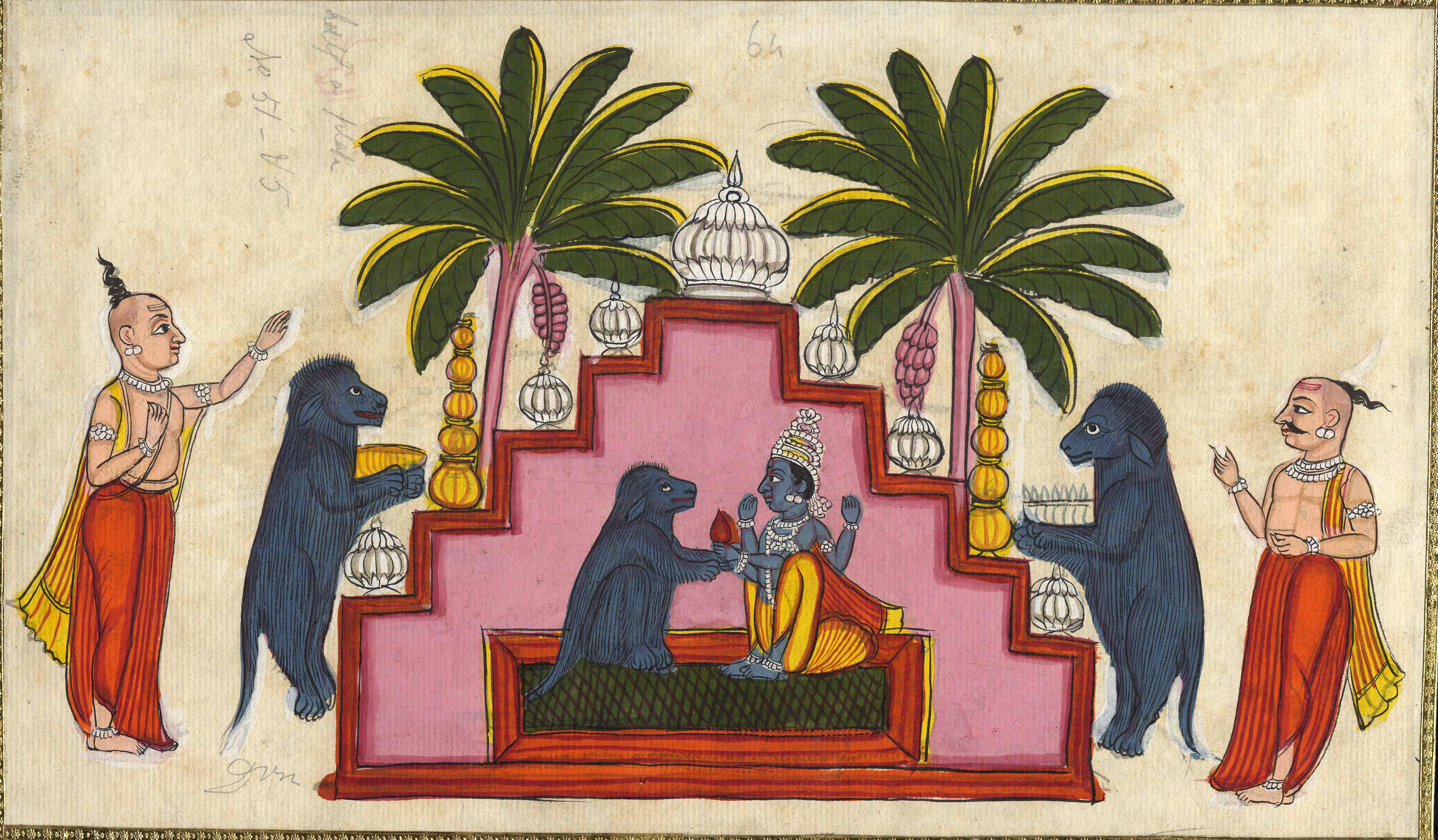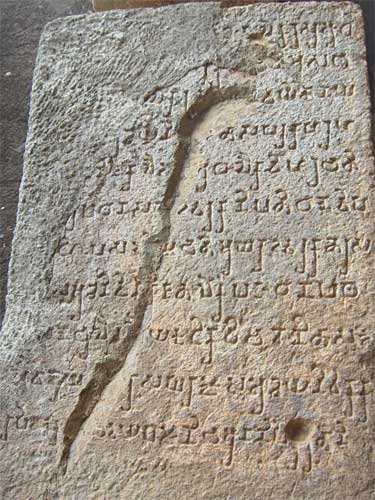|
Jambavan
Jambavan (Devanagari: जाम्बवान्), also known as Jambavanta (Devanagari: जाम्बवत्), is the king of the bears in Hindu texts. He emerges out of the mouth of Brahma when the creator deity yawns. He assists the Rama avatar of Vishnu in his struggle against the rakshasa king Ravana. In the Ramayana, he helps Hanuman realise his potential, just before his famous leap over to the island of Lanka.Patricia Turner, Charles Russell Coulter. ''Dictionary of ancient deities''. 2001, page 248 Jambavan was present at the Churning of the Ocean, and is supposed to have circled Vamana 21 times in a single leap, when he was acquiring the three worlds from Mahabali. Jambavan, together with Parashurama and Hanuman, is considered to be one of the few to have been present for both the Rama and the Krishna avataras. His daughter Jambavati was married to Krishna. Nomenclature Jambavan is also known as: * Jambavantan * Jambavanta (জাম্বৱন্ত, Assa ... [...More Info...] [...Related Items...] OR: [Wikipedia] [Google] [Baidu] |
Jambavati
Jambavati () is chronologically the second ''Ashtabharya'' of the Hindu god Krishna. She is the only daughter of the bear-king Jambavan. Krishna marries her when he defeats her father, Jambavan, in his quest to retrieve the stolen Syamantaka jewel. Nomenclature Jambavati, a patronymic, means daughter of Jambavan. Sridhara, a commentator on the ''Bhagavata Purana'', identifies her with Krishna's wife Rohini. However, another commentator Ratnagarbha disagrees. The ''Harivamsa'' also suggests that Rohini may be an alternate name of Jambavati. Jambavati is also given the epithets Narendraputri and Kapindraputra. Legend In the epic ''Mahabharata'', Jambavan is introduced as Jambavati's father. The ''Bhagavata Purana'' and the ''Harivamsa'' calls him the king of bears. Jambavati is an incarnation of the goddess Lakshmi, along with the junior wives of Krishna, as well as the Ashtabharya. Marriage to Krishna The marriage of Jambavati and Satyabhama to Krishna is closely linked ... [...More Info...] [...Related Items...] OR: [Wikipedia] [Google] [Baidu] |
Hanuman
Hanuman (; sa, हनुमान, ), also called Anjaneya (), is a Hindu god and a divine '' vanara'' companion of the god Rama. Hanuman is one of the central characters of the Hindu epic ''Ramayana''. He is an ardent devotee of Rama and one of the Chiranjivis. Hanuman is regarded to be the son of the wind-god Vayu, who in several stories played a direct role in Hanuman's birth, and considered to be an incarnation or son of Shiva in Shaivism. Hanuman is mentioned in several other texts, such as the epic ''Mahabharata'' and the various Puranas. Evidence of devotional worship to Hanuman is largely absent in these texts, as well as in most archeological sites. According to Philip Lutgendorf, an American Indologist, the theological significance of Hanuman and devotional dedication to him emerged about 1,000 years after the composition of the ''Ramayana'', in the 2nd millennium CE, after the arrival of Islamic rule in the Indian subcontinent.Paula Richman (2010), ''Revie ... [...More Info...] [...Related Items...] OR: [Wikipedia] [Google] [Baidu] |
Bhagavata Purana
The ''Bhagavata Purana'' ( sa, भागवतपुराण; ), also known as the ''Srimad Bhagavatam'', ''Srimad Bhagavata Mahapurana'' or simply ''Bhagavata'', is one of Hinduism's eighteen great Puranas (''Mahapuranas''). Composed in Sanskrit by Veda Vyasa, it promotes '' bhakti'' (devotion) towards Krishna, integrating themes from the Advaita (monism) philosophy of Adi Shankara, the Vishishtadvaita (qualified monism) of Ramanujacharya and the Dvaita (dualism) of Madhvacharya. It is widely available in almost all Indian languages. The ''Bhagavata Purana'', like other puranas, discusses a wide range of topics including cosmology, astronomy, genealogy, geography, legend, music, dance, yoga and culture. As it begins, the forces of evil have won a war between the benevolent ''devas'' (deities) and evil ''asuras'' (demons) and now rule the universe. Truth re-emerges as Krishna, (called " Hari" and " Vāsudeva" in the text) – first makes peace with the demons, understands ... [...More Info...] [...Related Items...] OR: [Wikipedia] [Google] [Baidu] |
Brahma
Brahma ( sa, ब्रह्मा, Brahmā) is a Hindu god, referred to as "the Creator" within the Trimurti, the trinity of supreme divinity that includes Vishnu, and Shiva.Jan Gonda (1969)The Hindu Trinity Anthropos, Bd 63/64, H 1/2, pp. 212–226. He is associated with creation, knowledge, and the '' Vedas''. Brahma is prominently mentioned in creation legends. In some '' Puranas'', he created himself in a golden embryo known as the Hiranyagarbha. Brahma is frequently identified with the Vedic god Prajapati.;David Leeming (2005), The Oxford Companion to World Mythology, Oxford University Press, , page 54, Quote: "Especially in the Vedanta Hindu Philosophy, Brahman is the Absolute. In the Upanishads, Brahman becomes the eternal first cause, present everywhere and nowhere, always and never. Brahman can be incarnated in Brahma, in Vishnu, in Shiva. To put it another way, everything that is, owes its existence to Brahman. In this sense, Hinduism is ultimately monotheisti ... [...More Info...] [...Related Items...] OR: [Wikipedia] [Google] [Baidu] |
Malay Language
Malay (; ms, Bahasa Melayu, links=no, Jawi: , Rencong: ) is an Austronesian language that is an official language of Brunei, Indonesia, Malaysia, and Singapore, and that is also spoken in East Timor and parts of the Philippines and Thailand. Altogether, it is spoken by 290 million people (around 260 million in Indonesia alone in its own literary standard named "Indonesian") across Maritime Southeast Asia. As the or ("national language") of several states, Standard Malay has various official names. In Malaysia, it is designated as either ("Malaysian Malay") or also ("Malay language"). In Singapore and Brunei, it is called ("Malay language"). In Indonesia, an autonomous normative variety called (" Indonesian language") is designated the ("unifying language" or lingua franca). However, in areas of Central to Southern Sumatra, where vernacular varieties of Malay are indigenous, Indonesians refer to the language as , and consider it to be one of their regiona ... [...More Info...] [...Related Items...] OR: [Wikipedia] [Google] [Baidu] |
Assamese Language
Assamese (), also Asamiya ( ), is an Indo-Aryan language spoken mainly in the north-east Indian state of Assam, where it is an official language, and it serves as a ''lingua franca'' of the wider region. The easternmost Indo-Iranian language, it has over 23 million speakers. Nefamese, an Assamese-based pidgin, is used in Arunachal Pradesh, and Nagamese, an Assamese-based Creole language, is widely used in Nagaland. The Kamtapuri language of Rangpur division of Bangladesh and the Cooch Behar and Jalpaiguri districts of India are linguistically closer to Assamese, though the speakers identify with the Bengali culture and the literary language. In the past, it was the court language of the Ahom kingdom from the 17th century. Along with other Eastern Indo-Aryan languages, Assamese evolved at least before the 7th century CE from the middle Indo-Aryan Magadhi Prakrit. Its sister languages include Angika, Bengali, Bishnupriya Manipuri, Chakma, Chittagonian, Hajong, ... [...More Info...] [...Related Items...] OR: [Wikipedia] [Google] [Baidu] |
Kannada Script
The Kannada script ( IAST: ''Kannaḍa lipi''; obsolete: Kanarese or Canarese script in English) is an abugida of the Brahmic family, used to write Kannada, one of the Dravidian languages of South India especially in the state of Karnataka. Kannada script is also widely used for writing Sanskrit texts in Karnataka. Several minor languages, such as Tulu, Konkani, Kodava, Sanketi and Beary, also use alphabets based on the Kannada script. The Kannada and Telugu scripts share very high mutual intellegibility with each other, and are often considered to be regional variants of single script. Other scripts similar to Kannada script are Sinhala script (which included some elements from the Kadamba script), and Old Peguan script (used in Burma). The Kannada script ( ''akṣaramāle'' or ''varṇamāle'') is a phonemic abugida of forty-nine letters. The character set is almost identical to that of other Brahmic scripts. Consonantal letters imply an inherent vowel. Letters ... [...More Info...] [...Related Items...] OR: [Wikipedia] [Google] [Baidu] |
Bengali Language
Bengali ( ), generally known by its endonym Bangla (, ), is an Indo-Aryan language native to the Bengal region of South Asia. It is the official, national, and most widely spoken language of Bangladesh and the second most widely spoken of the 22 scheduled languages of India. With approximately 300 million native speakers and another 37 million as second language speakers, Bengali is the fifth most-spoken native language and the seventh most spoken language by total number of speakers in the world. Bengali is the fifth most spoken Indo-European language. Bengali is the official and national language of Bangladesh, with 98% of Bangladeshis using Bengali as their first language. Within India, Bengali is the official language of the states of West Bengal, Tripura and the Barak Valley region of the state of Assam. It is also a second official language of the Indian state of Jharkhand since September 2011. It is the most widely spoken language in the Andaman and Nic ... [...More Info...] [...Related Items...] OR: [Wikipedia] [Google] [Baidu] |
Khmer Language
Khmer (; , ) is an Austroasiatic language spoken by the Khmer people, and the official and national language of Cambodia. Khmer has been influenced considerably by Sanskrit and Pali, especially in the royal and religious registers, through Hinduism and Buddhism. It is also the earliest recorded and earliest written language of the Mon–Khmer family, predating Mon and Vietnamese, due to Old Khmer being the language of the historical empires of Chenla, Angkor and, presumably, their earlier predecessor state, Funan. The vast majority of Khmer speakers speak Central Khmer, the dialect of the central plain where the Khmer are most heavily concentrated. Within Cambodia, regional accents exist in remote areas but these are regarded as varieties of Central Khmer. Two exceptions are the speech of the capital, Phnom Penh, and that of the Khmer Khe in Stung Treng province, both of which differ sufficiently enough from Central Khmer to be considered separate dialects of Khmer. ... [...More Info...] [...Related Items...] OR: [Wikipedia] [Google] [Baidu] |
Ramayana
The ''Rāmāyana'' (; sa, रामायणम्, ) is a Sanskrit epic composed over a period of nearly a millennium, with scholars' estimates for the earliest stage of the text ranging from the 8th to 4th centuries BCE, and later stages extending up to the 3rd century CE. ''Ramayana'' is one of the two important epics of Hinduism, the other being the ''Mahābhārata''. The epic, traditionally ascribed to the Maharishi Valmiki, narrates the life of Sita, the Princess of Janakpur, and Rama, a legendary prince of Ayodhya city in the kingdom of Kosala. The epic follows his fourteen-year exile to the forest urged by his father King Dasharatha, on the request of Rama's stepmother Kaikeyi; his travels across forests in the Indian subcontinent with his wife Sita and brother Lakshmana, the kidnapping of Sita by Ravana – the king of Lanka, that resulted in war; and Rama's eventual return to Ayodhya to be crowned king amidst jubilation and celebration. The ''Ramayana'' is ... [...More Info...] [...Related Items...] OR: [Wikipedia] [Google] [Baidu] |
Odia Language
Odia (, ISO: , ; formerly rendered Oriya ) is an Indo-Aryan language spoken in the Indian state of Odisha. It is the official language in Odisha (formerly rendered Orissa), where native speakers make up 82% of the population, and it is also spoken in parts of West Bengal, Jharkhand, Andhra Pradesh and Chhattisgarh. Odia is one of the many official languages of India; it is the official language of Odisha and the second official language of Jharkhand. The language is also spoken by a sizeable population of 700,000 people in Chhattisgarh. Odia is the sixth Indian language to be designated a classical language, on the basis of having a long literary history and not having borrowed extensively from other languages. The earliest known inscription in Odia dates back to the 10th century CE. History Odia is an Eastern Indo-Aryan language belonging to the Indo-Aryan language family. It descends from Odra Prakrit, which evolved from Magadhi Prakrit, which was spoken in east I ... [...More Info...] [...Related Items...] OR: [Wikipedia] [Google] [Baidu] |











